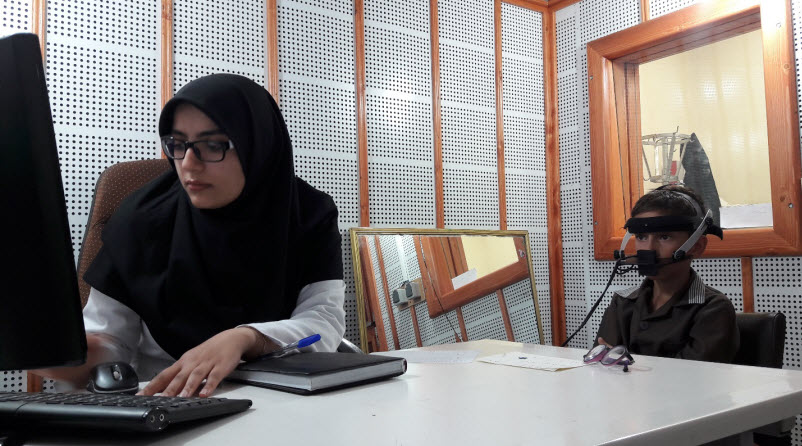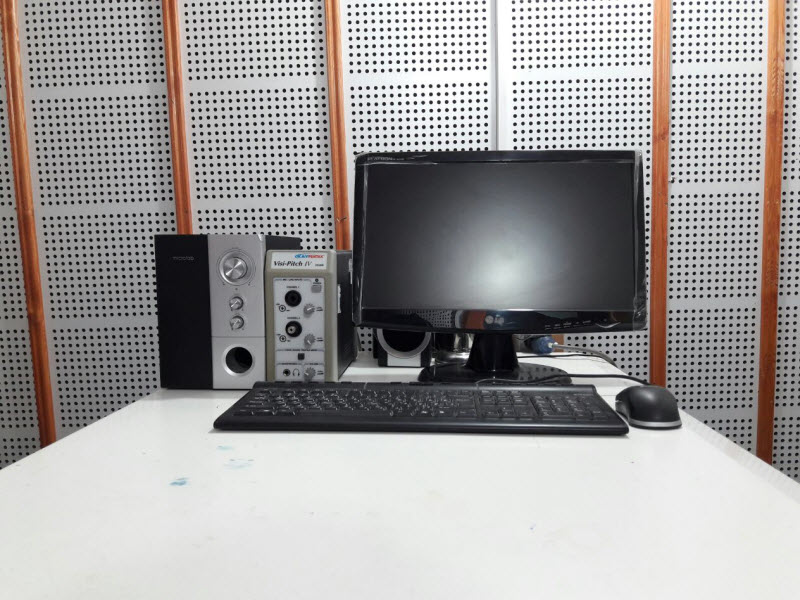The Laboratory of Speech and Voice of the Department of Speech Therapy is located in Ghaem Hospital of Mashhad, affiliated to Mashhad University of Medical Sciences (MUMS). This laboratory has devices such as CSL, Nasometer and Visipitch . By analyzing voices for research and treatment purposes, students are allowed to use these instruments. In addition, a videostroboscopy device is being purchased by the research grant of the department members.
|
|
|
|
|
|
|
|
Speech therapy is a rehabilitation therapy for patients with language and communication disorders. A language/speech disorder can cause problems in pronunciation of specific sounds or difficulty in understanding words or putting them together in a sentence or understandable format. By way of speech therapy, various effective devices and equipment developed for this cause. Here we explain around the most important devices in speech and language pathology.
Video laryngoscopy by Speech-Language Pathologist
Doctors and other medical specialists have always been on the lookout for techniques that would allow them to visualize the internal organs and structures of the body without the inconvenience of actually having to slice a patient open and look for themselves. Much of the diagnostic prowess of modern clinician’s rests on the use of advanced applications of the electromagnetic spectrum to penetrate the skin and develop a picture of what lies beneath. X-Ray, Magnetic Resonance Imaging, and Positron Emission Tomography have all become routine medical imaging procedures.
But one of the oldest techniques developed for this purpose is simply using lights, cameras, and mirrors to look into the body through the variety of natural orifices available without engaging in any knife work. This technique is called endoscopy and when the larynx and vocal apparatus specifically are being investigated, it is called laryngoscopy or laryngeal imaging. Laryngoscopy is a common and powerful technique used by speech language pathologists in diagnosing various speech and language disorders. Laryngeal imaging is not a simple procedure so it is more likely to be used by SLPs who are working in medical settings like hospitals.
Image-based analysis of the vocal folds vibrating can play an important role in diagnosing voice disorders. When the left and right vocal folds oscillate symmetrically, they can generally be ruled out as the source of vocalization problems. Direct observation via laryngeal imaging is the fastest and easiest way to confirm their behavior.
The technique is also sometimes used to investigate and provide therapy for dysphagia
Laryngeal Imaging Allows SLPs to View Vocalization in Action
Endoscopy was originally developed to investigate the larynx and only later was adapted to looking at other internal organs. As the first type of endoscopic imaging, it is also among the most common and most frequently used.
Although they might not be able to name it immediately, most Americans instinctively recognize this original type of laryngoscope from decades of medical television shows.
Every scene in a modern TV drama showing a patient being intubated—usually a moment of high drama—includes a cool, intense professional staring down a laryngoscope to thread the endotracheal tube through the patient’s vocal cords to keep their airway open.
The curved blade, mirrors, and lights of a basic laryngoscope look pretty intimidating and they effectively prevent the patient from even attempting to make a normal effort at speaking. In some cases, local anesthetic is used, making it even harder to observe the larynx in a normal way. Apart from observing gross topological malformation, this is very limiting for speech pathology uses.
Becoming Qualified to Perform Laryngeal Imaging
As you might imagine, special training is required before you are allowed to shove a camera into someone’s throat or nose. According to ASHA (American Speech-Language-Hearing Association), strobovideolaryngoscopy of any sort may be used by SLPs only for the purposes of assessing voice production and vocal function, or as a therapeutic aid and biofeedback system during treatment. They are not qualified to use the technique for medical purposes, so they frequently work together with otolaryngolists or other physicians both in performing laryngoscopy procedures and when evaluating the results.
State Licensing in Endoscopy
Because of this overlap in function, you will also need to consult your specific state licensing laws to determine if you can perform laryngoscopies as a speech-language pathologist. Many states do not explicitly address the issue, while others, such as Missouri and New Jersey, place it firmly within the SLP scope of practice. But others, such as Indiana, view endoscopy as an exclusively medical procedure and either prohibit SLPs from performing it or require they do so under the direct supervision of an individual with a medical license.
Transcranial Direct-Current Stimulation (tDCS)
Transcranial Direct-Current Stimulation (tDCS) is a contemporary, portable, non-invasive neuromodulator technique that delivers a low electric current to the scalp. A fixed current between 1 and 2 mA is typically applied. tDCS works by applying a positive (anodal) or negative (cathodal) current via electrodes to an area, facilitating the depolarization or hyperpolarization of neurons, respectively. The positioning of the anode and cathode electrodes is used to influence how current flows, and where in the brain it does. The current delivered by tDCS is not considered strong enough to trigger an action potential in a neuron; its sub-threshold effect works by bringing the neurons closer to, or farther from firing. Plainly, tDCS augments the resting voltage of the neuronal membrane to prod a neuron’s activity in a desired direction. In this way, tDCS may work by strengthening or weakening synaptic transmission between neurons by augmenting synaptic plasticity which is, in turn, the cellular basis of learning. tDCS is often combined with training. Training in itself produces learning (synaptic plasticity), and concurrent tDCS amplifies these effects (enhances synaptic plasticity). Some areas tDCS is currently being explored include: depression, schizophrenia, aphasia, addiction, epilepsy, chronic pain (migraine, fibromyalgia), attention, and motor rehabilitation.
Electropalatography
Electropalatography was originally conceptualized and developed as a tool for phonetics research to improve upon traditional palatography methods.
academic language researchers used early electropalatography tools to obtain accurate information regarding tongue-to-palate contact in a number of foreign languages.
- In static palatography, which is still very useful especially in fieldwork (e.g., Ladefoged, 2003), the roof of the mouth is coated in a mixture of olive oil and powdered charcoal and the subject produces a consonant.
Details of the consonant's place of articulation and stricture are obtained from a photograph taken of the roof of the mouth showing where the powder was wiped-off and sometimes also of the tongue (which is coated in the powder at the point where tongue-palate contact was made).
- Dynamic electropalatography (Hardcastle, 1972; Hardcastle et al, 1991) is an extension of this technique in which tongue-palate contacts are recorded as a function of time.
In dynamic palatography, an acrylic palate is custom-made for each subject and fixed to the roof of the mouth using clasps placed over the teeth.
The palate is very thin and contains a number of electrodes that are exposed to the surface of the tongue.
- Electropalatography is an excellent tool for studying consonant cluster overlap and timing.
- It also has an important application in the diagnosis and the treatment of speech disorders.
- Another major advantage of EPG is that there is often a reasonably transparent relationship between phonetic quality and EPG output: a [t] really does show up as contacts in the alveolar zone, the different groove widths between [s] and [ʃ] are usually very clearly manifested in EPG displays, and coarticulatory and assimilatory influences can often be seen and quantified.
Electroglottograph
Electroglottograph or EGG is a system which gives an information on the closure of vocal folds by measuring the electrical resistance between two electrodes placed around the neck. Even if the signal provides only an approximate value of the glottis surface, it gives a very good information about period of vocal folds’ vibration, especially because we are at the source of the phonation (no influence of vocal tract) and because there is no aerodynamic noise.
Acoustic analysis by PRAAT
PRAAT is a computer program for analyzing, synthesizing, and manipulating speech. It has been developed since 1992 by Paul Boersma and David Weenink at the Institute of Phonetic Sciences of the University of Amsterdam. There are versions for most of the common operating systems: Macintosh, Windows, Linux, and several Unix workstations (Solaris, Silicon Graphics, Hewlett-Packard). By September 2001, there were more than 5,000 registered users in 99 countries.
PRAAT allows you to record a sound with your microphone or any other audio input device, or to read a sound from a sound ®le on disk. You will then be able to have a look `inside' this sound. The upper half of the sound window will show you a visible representation of the sound (the wave form). The lower half will show you several acoustic analyses: the spectrogram (a representation of the amount of high and low frequencies available in the signal) is painted in shades of grey; the pitch contour (the frequency of periodicity) is drawn as a cyan curve; and formant contours (the main constituents of the spectrogram) are plotted as red dots. PRAAT is most often used with speech sounds, in which case the pitch contour is associated with the vibration of the vocal folds and the formant contours are associated with resonances in the vocal tract. But the use of PRAAT is certainly not limited to speech sounds: musicians and bio-acousticians use it for the analysis of sounds produced, and the interpretation of the three analyses will change accordingly.





